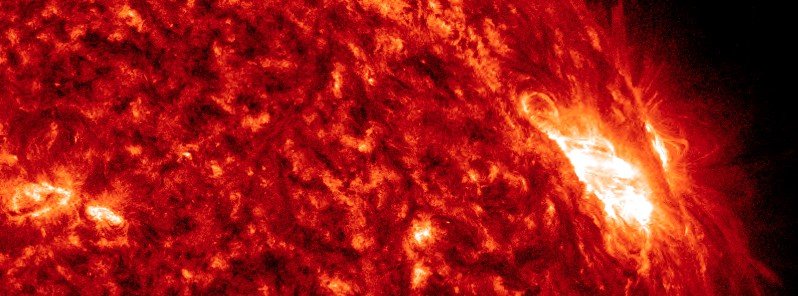Modest CME glancing blow from May 28 long-duration solar flare

A small part of coronal mass ejection (CME) produced by a long-duration C-class solar flare on May 28 hit Earth on June 2, 2021, barely disturbing Earth's magnetic field. Solar wind parameters are likely to become slightly enhanced due to the influence of a negative polarity CH HSS combined with lingering weak CME influence over the next 24 hours.
Solar wind speeds impulsively increased from 280 km/s to 320 km/s at 12:15 UTC on June 2, 2021, due to the delayed arrival of CME produced by a long-duration C9.4 solar flare on May 28.
Solar wind speed later rose to a modest 330 km/s. Simultaneously, solar wind density increased from 9 ppcm3 to 22, then later to 42 ppcm3. Bt increased from 3 nT to 7 nT, staying slightly elevated for only three hours.


Following the weak CME passage over DSCOVR spacecraft at L1 point, a modest response was measured at the global network of magnetometers, falling short of a typical sudden impulse signature. Kp-index increased only to a 3 — unsettled levels — at 15:00 UTC on June 2, before returning back to quiet conditions.
"This was a very modest CME glancing blow," SWPC forecasters said.
Solar wind parameters are likely to become slightly enhanced due to the influence of a negative polarity CH HSS combined with lingering weak CME influence over the next 24 hours. Levels should remain elevated on June 3 and 4 as CH influences persist. A return to mostly ambient conditions is expected on June 5.
Consequently, the geomagnetic field is expected to undergo weak enhancements, with unsettled to active conditions due to the influence of a negative polarity CH HSS combined with weak lingering CME influence over the next 24 hours. Levels should remain elevated on June 3 and 4, followed by a return to mostly ambient conditions on June 5.


Solar activity was at very low levels on June 2 and is expected to remain at very low levels, with a slight chance for C-class flares through June 5.
The greater than 2 MeV electron flux was at normal to moderate levels and is expected to remain at those levels through June 5. The greater than 10 MeV proton flux was steady at background levels and is forecast to persist at background levels through June 5.
Featured image credit: NASA/SDO AIA/304, TW

Commenting rules and guidelines
We value the thoughts and opinions of our readers and welcome healthy discussions on our website. In order to maintain a respectful and positive community, we ask that all commenters follow these rules:
We reserve the right to remove any comments that violate these rules. By commenting on our website, you agree to abide by these guidelines. Thank you for helping to create a positive and welcoming environment for all.